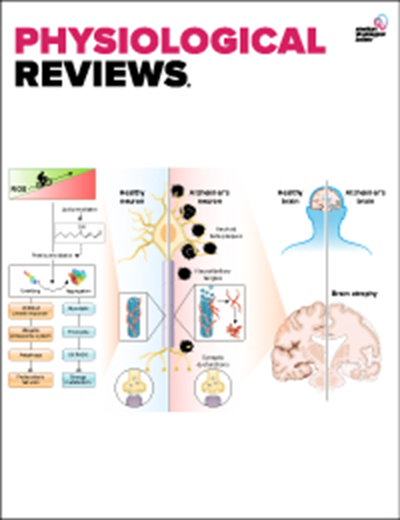Neuronal glucose sensing mechanisms and circuits in the control of insulin and glucagon secretion
IF 28.7
1区 医学
Q1 PHYSIOLOGY
引用次数: 0
Abstract
Glucose homeostasis is mainly under the control of the pancreatic islet hormones insulin and glucagon, which, respectively, stimulate glucose uptake and utilization by liver, fat, and muscle or glucose production by the liver. The balance between the secretion of these hormones is under the control of blood glucose concentrations. Indeed, pancreatic islet b-cells and a-cells can sense variations in glycemia and respond by an appropriate secretory response to restore euglycemia. However, the secretory activity of these cells is also under multiple additional metabolic, hormonal, and neuronal signals that combine to ensure the perfect control of glycemia over a lifetime. The central nervous system (CNS), which has an almost absolute requirement for glucose as a source of metabolic energy and, thus, a vital interest in ensuring that glycemic levels never fall below ~5mM, is equipped with populations of neurons responsive to changes in glucose concentrations. These neurons control pancreatic islet cells secretion activity in multiple ways: through both branches of the autonomic nervous system, through the hypothalamic-pituitary-adrenal axis, and by secreting vasopressin (AVP) in the blood at the level of the posterior pituitary. Here, we will present the autonomic innervation of the pancreatic islets; the mechanisms of neurons activation by a rise or a fall in glucose concentration; how current viral tracing, chemogenetic, and optogenetic techniques allow to integrate specific glucose sensing neurons in defined neuronal circuits that control endocrine pancreas function. Finally, how genetic screens in mice can untangle the diversity of the hypothalamic mechanisms controlling the response to hypoglycemia.控制胰岛素和胰高血糖素分泌的神经元葡萄糖传感机制和回路
葡萄糖稳态主要受胰岛激素胰岛素和胰高血糖素的控制,这两种激素分别刺激肝脏、脂肪和肌肉摄取和利用葡萄糖,或刺激肝脏产生葡萄糖。这些激素分泌之间的平衡受血糖浓度的控制。事实上,胰岛 b 细胞和 a 细胞能够感知血糖的变化,并通过适当的分泌反应来恢复优血症。然而,这些细胞的分泌活动还受到新陈代谢、荷尔蒙和神经元等多种额外信号的影响,这些信号共同作用,确保在人的一生中完美地控制血糖。中枢神经系统(CNS)几乎绝对需要葡萄糖作为新陈代谢的能量来源,因此,确保血糖水平永远不低于约 5 毫摩尔对中枢神经系统来说至关重要。这些神经元通过多种方式控制胰岛细胞的分泌活动:通过自律神经系统的两个分支、通过下丘脑-垂体-肾上腺轴以及通过在垂体后叶水平分泌血液中的血管加压素(AVP)。在这里,我们将介绍胰岛的自主神经支配;葡萄糖浓度升高或降低激活神经元的机制;目前的病毒追踪、化学遗传和光遗传技术如何将特定的葡萄糖传感神经元整合到控制胰腺内分泌功能的神经元回路中。最后,小鼠基因筛选如何解开控制低血糖反应的下丘脑机制的多样性。
本文章由计算机程序翻译,如有差异,请以英文原文为准。
求助全文
约1分钟内获得全文
求助全文
来源期刊

Physiological reviews
医学-生理学
CiteScore
56.50
自引率
0.90%
发文量
53
期刊介绍:
Physiological Reviews is a highly regarded journal that covers timely issues in physiological and biomedical sciences. It is targeted towards physiologists, neuroscientists, cell biologists, biophysicists, and clinicians with a special interest in pathophysiology. The journal has an ISSN of 0031-9333 for print and 1522-1210 for online versions. It has a unique publishing frequency where articles are published individually, but regular quarterly issues are also released in January, April, July, and October. The articles in this journal provide state-of-the-art and comprehensive coverage of various topics. They are valuable for teaching and research purposes as they offer interesting and clearly written updates on important new developments. Physiological Reviews holds a prominent position in the scientific community and consistently ranks as the most impactful journal in the field of physiology.
 求助内容:
求助内容: 应助结果提醒方式:
应助结果提醒方式:


